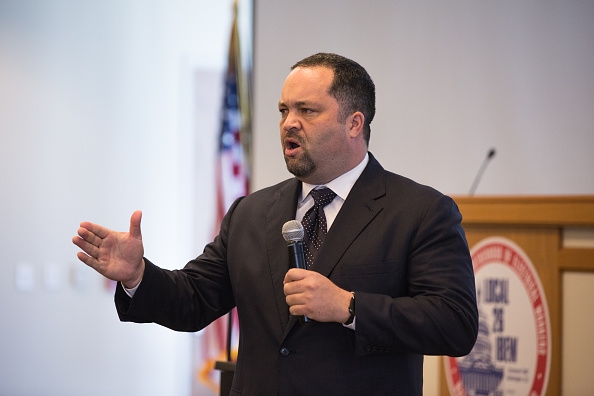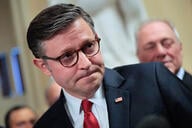You have /5 articles left.
Sign up for a free account or log in.

Ben Jealous, a Maryland gubernatorial candidate, is one of many Democrats running on free college this year.
Getty Images
WASHINGTON -- After free college played a big role in the fight for the Democratic presidential nomination in 2016, Donald Trump's surprising election put a moratorium on discussions of a large-scale college-affordability plan.
But for the past two years, free college programs have continued to launch at the state and local level. And this election cycle, more candidates than ever are running on the idea.
Ben Jealous is running for governor of Maryland on a campaign to make community college free and four-year college “debt-free.” David Garcia is campaigning for governor in Arizona on a plan to make four-year public college tuition-free. And Ned Lamont in Connecticut wants to make the first two years free at any public college or university in the state. In all, nearly 10 Democratic gubernatorial candidates are running on some kind of free-college plan.
And even more candidates for Congress are campaigning on free college.
Bernie Sanders's 2016 campaign for president drew excitement from many younger voters in part due to ambitious proposals like free college and Medicare for all. And with college price still a pressing issue, progressive candidates running for both statewide and federal offices this year see free college as a winning idea. Even some moderate Democrats have latched on to the idea.
Activist groups say the issue can help excite voters. The number of candidates running on ambitious college-affordability proposals shows free college wasn’t just a flash-in-the-pan policy idea, they say, but has staying power as a mainstream concept.
“What we’re seeing now is the political conversation is finally catching up to where the voting population is on this issue,” said Maggie Thompson, executive director of Generation Progress, the youth engagement arm of the Center for American Progress, a center-left think tank based here.
Free college appears to have broken through as a national political issue just as many in Washington's liberal policy circles are critical or outright opposed to the proposals. And the main super-PAC backing Democratic House candidates earlier this year sought to throw cold water on the notion that free college would appeal to white working class voters seen as key to winning in many swing states.
However, leaders of congressional Democrats in Washington have opted not to push a national agenda, instead letting candidates themselves emphasize the issues important to voters in their districts. And adhering to a party line is even more unlikely in a year when House candidates like Alexandria Ocasio-Cortez in New York and Ayanna Pressley in Massachusetts have knocked off longtime Democratic incumbents. Those primary victories have demonstrated the growing strength of national progressive organizations like Our Revolution and Justice Democrats, which have steered funding, volunteers and campaign know-how to candidates who back priorities like free college and Medicare for all.
“These are proposals that are unlike what we’ve seen from the Democratic Party,” said Nasim Thompson, executive director of Justice Democrats, a progressive political action committee. “These are very bold, specific, tangible positions.”
Thompson of Generation Progress said the group can measure its success partly by specific stands candidates are taking on college affordability.
“Until 2016, it wasn’t typical for a presidential candidate to have a strong position on affordability and debt,” she said. “People gave lip service to affordability but weren’t being held to a specific vision of what that meant.”
But if the free-college push is reshaping the message carried by many Democratic candidates, it’s also revealing a deep split within the party and among left-of-center policy advocates over how to make college degrees more attainable.
Debating How to Tackle College Affordability
While the notion of free college is straightforward, unpacking what that means can be a complex exercise.
Some candidates want four years of free tuition at public colleges. Others have promised two years of free college at any public institution and debt-free four-year college. And others still support free community college -- an option endorsed in House Democrats’ proposal to reauthorize the Higher Education Act released this summer.
The free-college programs already enacted in states like Oregon, Tennessee and New York illustrate the extent to which state-funded programs are shaped by local circumstances. The perceived shortcomings of those programs also point to the reasons many liberal groups and education policy outfits are skeptical about free-college proposals. For example, these and most other state-level programs are “last-dollar” models -- the state covers whatever need is left unmet after a student exhausts their federal aid options, so much of those resources go to middle-class students, not the poor.
“Obviously they’re very expensive. More importantly, they’re regressive and aren’t really the most efficient way to target the limited resources we have to students who need it the most,” said Tamara Hiler, deputy director of education at Third Way, a center-left think tank.
Hiler also pushed back against the notion that because more candidates than ever are talking about free college, the idea is going mainstream or it will translate to a tangible policy agenda, especially on the federal level.
“Free college sounds really good on a bumper sticker, and it’s a really great way for a candidate to fire up their base, especially on the progressive side as a campaign promise,” she said. “That doesn’t mean it’s going to translate into some sort of viable policy agenda in the next year.”
Two recent reports from the Institute for Higher Education Policy and Ed Trust -- both nonpartisan groups focused on equity in postsecondary education -- reinforced concerns many already had about free college. Both reports found that tuition-free college programs often fail to meet the needs of the poorest students and overlook costs of attendance beyond tuition.
But Morley Winograd, president of the Campaign for Free College Tuition, said those findings were unsurprising. As a universal program, free college by design is not well targeted, he said. When programs are means tested, he said, they lose broad-based support. And at the state and local level, free college has gotten bipartisan support from some Republican governors, Winograd said.
“The problem that we have is that their argument is never one that has carried the day,” he said of free college’s critics. “It’s a self-indictment of their idea.”
Congress doesn't have much of a recent track record for seriously boosting financial aid that's targeted to low-income students. The maximum Pell Grant, for example, got a $100 boost from lawmakers in a 2019 appropriations deal. But the $6,195 maximum grant still won’t cover even a third of the full cost of attendance at a typical four-year public college.
The momentum behind free college this campaign season is revealing the tension between the appeal of universal programs and the goal of greater equity in higher ed. Beyond free college, though, Democratic officeholders or candidates have made few aggressive attempts to tackle college affordability. No one has seriously pushed, for example, plans that would dramatically raise the purchasing power of the Pell Grant -- a proposal offered this year by the National College Access Network.
Legislation introduced in March by Senator Brian Schatz, a Hawaii Democrat, builds on Sanders’s proposal by aiming to cover the full cost of attendance, rather than just making public college tuition free. Both the Sanders and Schatz bills count as co-sponsors potential 2020 Democratic presidential contenders like Kamala Harris, Elizabeth Warren and Cory Booker.
The Sanders proposal is projected to cost $47 billion annually, while the Schatz bill would cost $84 billion in its first year.
Reid Setzer, government affairs director for Young Invincibles, said the group thinks the legislation offers the best way to navigate the tension between universal and targeted programs. But Setzer said Young Invincibles isn’t as concerned with free or “debt-free” branding as other groups.
“If you’re deriving the most value from calling it free college, that’s what you should do,” he said. “At the end of the day, there’s a lot you’ll have to work out in the application of this.”
Some activists are measuring their progress by getting candidates to talk about free college and having them talk about the right kind of solutions.
"Over the last couple years, it's an issue more and more candidates are talking about," said Aija Nemer-Aanerud, an organizer with People's Action. "It's about that and it's about getting them to talk about it in the right way."
Nemer-Aanerud said the organization wants to avoid "last-dollar" funding for those programs. She said Jess King, a Democrat running for Congress in Pennsylvania, provides an example of how to tackle the issue while running in a "moderate" district.
King says she wants to tax Wall Street to eliminate tuition at public colleges and universities and add federal matching funds so that the cost of college isn't more than what students can earn working 10 hours per week at a minimum-wage job.
Even if the Democrats recapture the House and -- less likely -- the Senate this fall though, a federal solution is a long way from going anywhere.
Brian Sponsler, vice president of policy and director of postsecondary and work-force development at the Education Commission on the States, said over the last two legislative cycles, free-college proposals have captured the attention of state lawmakers looking to show they’re taking a college affordability seriously.
But he said he expects that to the extent state legislatures pursue free-college programs in the next year, they’re likely to be “last-dollar” programs that fill the gap in costs not covered by federal aid.
“We’re certainly seeing a lot of energy around [free college]. A caveat to that is the energy and interest, at least from what we’re observing, is not crystallizing itself into new resources,” he said. “It’s not the case that we’re seeing huge new investments in state aid that’s coming through a free-college proposal.”
Our Revolution doesn’t see the end goal of the debate as one specific model for paying for college but a larger reconception of higher ed and its place as a public good, said the group’s executive director, Heather Gautney.
“What we’re fighting for is universal higher education,” she said. “We’re certainly not purists on this. The ideal here is to view higher education as a public good in America -- to make sure that everyone who desires to attend an institution of higher education can without walking away with tens of thousands of dollars in debt.”



